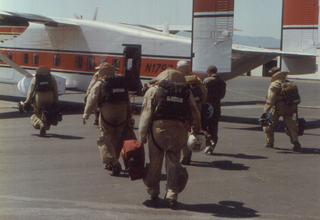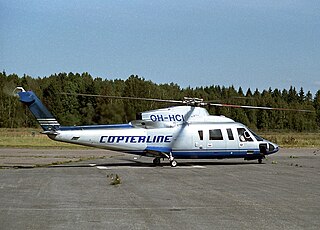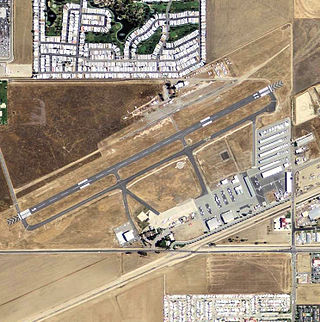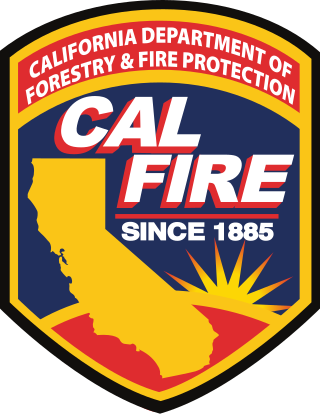
Smokejumpers are specially trained wildland firefighters who provide an initial attack response on remote wildfires. They are inserted at the site of the fire by parachute. This allows firefighters to access remote fires in their early stages without needing to hike long distances carrying equipment and supplies. Traditional terrestrial crews can use only what they can carry and often require hours and days to reach fire on foot. The benefits of smokejumping include the speed at which firefighters can reach a burn site, the broad range of fires a single crew can reach by aircraft, and the larger equipment payloads that can be delivered to a fire compared to pedestrian crews.

Aerial firefighting, also known as waterbombing, is the use of aircraft and other aerial resources to combat wildfires. The types of aircraft used include fixed-wing aircraft and helicopters. Smokejumpers and rappellers are also classified as aerial firefighters, delivered to the fire by parachute from a variety of fixed-wing aircraft, or rappelling from helicopters. Chemicals used to fight fires may include water, water enhancers such as foams and gels, and specially formulated fire retardants such as Phos-Chek.

Rocky Mountain Metropolitan Airport is a public-use airport located in Broomfield, Colorado, United States. The airport is owned and operated by Jefferson County and is situated midway between Denver and Boulder on U.S. Highway 36. It is located 16 miles (26 km) northwest of the central business district of Denver, and is the closest airport to downtown Denver. The airport covers 1,700 acres (688 ha) and has three runways. Formerly known as Jefferson County Airport or Jeffco Airport, the airport was renamed Rocky Mountain Metropolitan Airport on October 10, 2006, although it is sometimes referred to as Rocky Mountain Regional Airport, e.g., on 2007–2012 county planning documents.

Copterline Flight 103 (AAQ103) was a Copterline helicopter flight en route to Helsinki, Finland from Tallinn, Estonia that crashed into the Tallinn Bay on 10 August 2005, at 12:45 local time.

British International Helicopter Services (BIH), owned by Bristow Group, is a British-owned helicopter operator. It operates a fleet of ten helicopters covering search and rescue, offshore, defence, charter and flying training activities from its bases at Newquay Airport, Coventry Airport and RAF Mount Pleasant in the Falkland Islands.

The Sikorsky S-64 Skycrane is an American twin-engine heavy-lift helicopter. It is the civilian version of the United States Army's CH-54 Tarhe. It is currently produced as the S-64 Aircrane by Erickson Inc.

Hemet-Ryan Airport is an airport near Egan, CA.

The California Department of Forestry and Fire Protection is the fire department of the California Natural Resources Agency in the U.S. state of California. It is responsible for fire protection in various areas under state responsibility totaling 31 million acres, as well as the administration of the state's private and public forests. In addition, the department provides varied emergency services in 36 of the state's 58 counties via contracts with local governments. The department's current director is Joe Tyler, who was appointed March 4, 2022, by Governor of California Gavin Newsom.

The DC-10 Air Tanker is a series of American wide-body jet air tankers, which have been in service as an aerial firefighting unit since 2006. The aircraft, operated by the joint technical venture 10 Tanker Air Carrier, are converted wide-body McDonnell Douglas DC-10-30 passenger jetliners, and are primarily used to fight wildfires, typically in rural areas. The turbofan-powered aircraft carry up to 9,400 US gallons of water or fire retardant in an exterior belly-mounted tank, the contents of which can be released in eight seconds. Four air tankers are currently in operation, all DC-10-30 aircraft, with the call-signs Tanker 910, 911, 912 and 914. The original Tanker 910, a DC-10-10, was retired in 2014.

The Sikorsky S-61L and S-61N are civil variants of the SH-3 Sea King military helicopter. They were developed and produced by the American helicopter manufacturer Sikorsky Aircraft.

The CAL FIRE Aviation Management Program is a branch of the California Department of Forestry and Fire Protection. Due to the frequency and severity of wildfires in California, the state has elected to establish its own aerial firefighting force rather than rely solely on contract or national resources. The Aviation Management Program is based at McClellan Airfield near Sacramento, California.

The Modular Airborne FireFighting System (MAFFS) is a self-contained unit used for aerial firefighting that can be loaded onto both military cargo transport Lockheed C-130 Hercules and Embraer C-390 Millennium, which then allows the aircraft to be used as an air tanker against wildfires. This allows the U.S. Forest Service (USFS) to use military aircraft from the Air National Guard and Air Force Reserve to serve as an emergency backup resource to the civilian air tanker fleet.

Helitack crews are teams of wildland firefighters who are transported by helicopter to wildfires. Helicopters provide rapid transport, enabling helitack crews to quickly respond and assess a wildfire situation. Helitack crews may land near a wildfire or, if equipped and trained, rappel from a hovering helicopter. Once on the ground, crews build firelines using hand tools, chainsaws, and other firefighting tools. They often remain overnight in remote locations. After they have completed their assignment, crew members may pack up to 120 pounds of equipment over difficult terrain to reach a pick-up point. Rappellers often prepare helispots that provide better access to a fire. Helicopter crew members may also perform other duties such as tree falling, firing operations, and managing helibases.

In 2002, two large airtankers – a Lockheed C-130 Hercules and a Consolidated PB4Y-2 Privateer – crashed about a month apart while performing aerial firefighting operations. These crashes prompted a review of the maintenance and use of the entire U.S. large airtanker fleet. Ultimately, the whole fleet was grounded, dramatically reducing the resources available to fight major wildfires. Both aircraft were owned by Hawkins & Powers Aviation of Greybull, Wyoming and operated under contract to the United States Forest Service (USFS). The crashes occurred in one of the worst fire seasons in the last half century, one in which 73,000 fires burned 7.2 million acres (29,000 km2) of land.
Carson Helicopters, Inc is a helicopter-operating company based in Perkasie, Pennsylvania, United States. Carson operates a fleet of Sikorsky S-61 helicopters in aerial lift services and aerial firefighting. Carson developed the "Carson Blade" for the S-61 and H-3 Sea King. In 2010, Carson Helicopters, Inc. partnered with Sikorsky Aircraft to develop and manufacture the S-61T, an upgraded version of the S-61 helicopter.

Los Angeles Airways Flight 841 was a Sikorsky S-61 helicopter that crashed at 5:50 p.m. on Wednesday, May 22, 1968, in the city of Paramount, California. All twenty passengers and three crew members were killed. The aircraft was destroyed by impact and fire. The probable cause of the accident was a mechanical failure in the blade rotor system, which then allowed one blade to strike the side of the fuselage. As a result, the other four blades were thrown out of balance. All five rotor blades then broke and the rear fuselage and tail separated from the rest of the airframe. The cause of the mechanical failure is undetermined. At the time, it was the worst helicopter-related accident in U.S. aviation history, not to be surpassed until the 1986 Grand Canyon mid-air collision which killed 25.

Aero Union Corporation was an aircraft operation and maintenance company based in Chico, California, United States. It was known for operating aerial firefighting aircraft, training crews and making custom designed firefighting systems tailored to specific aircraft requirements. After years of controversies regarding the operation of the company and the safety of its aircraft, the U.S. Forest Service (USFS) canceled its contract, and the company was forced to shut down soon after.

On August 18, 1937, a lightning strike started the Blackwater Fire in Shoshone National Forest, approximately 35 miles (56 km) west of Cody, Wyoming, United States. Fifteen firefighters were killed by the forest fire when a dry weather front caused the winds to suddenly increase and change direction. The fire quickly spread into dense forest, creating spot fires that trapped some of the firefighters in a firestorm. Nine firefighters died during the fire and six more died shortly thereafter from severe burns and respiratory complications. Another 38 firefighters were injured. The fire killed more professional wildland firefighters in the U.S. than any other in the 103 years between the Great Fire of 1910 and the Yarnell Hill Fire in 2013.

The 2015 Cape wildfires were a series of wildfires that burned across the Western Cape from February to April 2015. Major fires burned across the Cape Peninsula starting on 1 March in Muizenberg and burning until 9 March, when firefighters extinguished it. The fire resulted in 1 death, 56 injuries, over 6,900 hectares of burnt land, and 13 damaged properties, of which 3 were destroyed. The cause of the fire was later determined to be arson. There were also major fires near Wellington and Porteville starting in February, which claimed the lives of 3 firefighters and a fire in Stellenbosch that caused the evacuation of the University of Stellenbosch and burned over 2,900 hectares of land.

Coulson Aviation is an aviation company headquartered in Port Alberni, British Columbia, Canada. The company's fleet specialises in air tankers used for aerial firefighting. It operates in Canada, the United States, Australia and Chile.



















